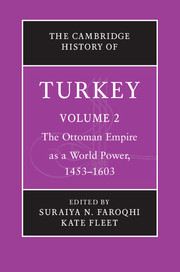Book contents
- Frontmatter
- Contents
- List of Illustrations
- List of Maps
- List of Contributors
- Chronology
- A note on transliteration
- Maps
- 1 Introduction
- Part I An Expanding Empire
- Part II Government, Economic Life and Society
- 7 Government, administration and law
- 8 The Ottoman government and economic life
- 9 Ottoman armies and warfare, 1453–1603
- 10 Religious institutions, policies and lives
- 11 Ottoman population
- Part III Culture and the Arts
- Glossary
- Bibliography
- Index
- References
9 - Ottoman armies and warfare, 1453–1603
from Part II - Government, Economic Life and Society
Published online by Cambridge University Press: 05 July 2013
- Frontmatter
- Contents
- List of Illustrations
- List of Maps
- List of Contributors
- Chronology
- A note on transliteration
- Maps
- 1 Introduction
- Part I An Expanding Empire
- Part II Government, Economic Life and Society
- 7 Government, administration and law
- 8 The Ottoman government and economic life
- 9 Ottoman armies and warfare, 1453–1603
- 10 Religious institutions, policies and lives
- 11 Ottoman population
- Part III Culture and the Arts
- Glossary
- Bibliography
- Index
- References
Summary
Introduction
Between 1453 and 1566, the Ottoman Empire reached the apogee of its military potential; during the later sixteenth century, sultans’ armies were still formidable, but not as strong as they had been. Especially after 1580, former glory started to fade away, as the long war in Hungary (1593–1606) ended with the mutual exhaustion of both Ottomans and Habsburgs and without major gains for the empire of the sultans. By contrast, the reigns of Mehmed II (r. 1451–81), Selim I (r. 1512–20) and Süleyman I (r. 1520–66) featured splendid territorial expansion, aspirations for world hegemony and an extraordinary capability to match and overcome the adversaries’ war potential. Based on accumulated wealth and power, after about 1530 the Ottomans for a while seem to have aimed at universal political supremacy and for this purpose developed a “grand strategy”, to use a currently fashionable term.
When Mehmed II acceded to the throne, there was no enemy in the vicinity who could have seriously contested his superiority. Byzantium was in a desperate situation, reduced to a city-state which would fall very soon, on 29 May 1453. Nor was it difficult to subjugate the remaining Greek principalities, partly because they were so eager to resort to Ottoman aid. Nor could the Balkan states withstand the Ottoman advance. Only Hungary, though close to the borders of the sultan’s realm, was in a somewhat stronger position: Mehmed II had not succeeded in his attack against Belgrade in 1456, and King Matthias (r. 1458–90) in 1463 had conquered the fortress town of Jajce. Thus, from an Ottoman military viewpoint, the kingdom of Hungary remained a somewhat remote target, but although in this period its ruler was quite a dangerous rival to the sultan, he mostly focused on European matters.
- Type
- Chapter
- Information
- The Cambridge History of Turkey , pp. 276 - 319Publisher: Cambridge University PressPrint publication year: 2012



